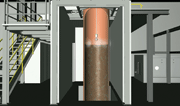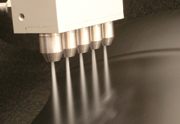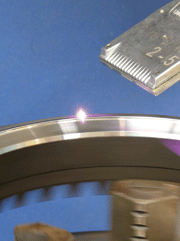E-Archive
Articles
in Vol. 11 - September Issue - Year 2010
Cleaning Parts with Blasting Processes. Brilliantly Blasted Surfaces

The rotating water jet removes all slag deposits from the melting crucibles so thoroughly that no further cleaning is required. Image source: RST GmbH

CO2 blasting with dry ice can also be used for paint stripping and the removal of coatings. Image source: Fraunhofer IPK

CO2 snow blasting is used more and more frequently to clean plastic parts before painting. Reasons include environmental compatibility, as well as reduced costs in comparison with wet-chemical processes. Image source: acp

In the case of laser basting, the cleaning effect is based on vaporisation of the contaminants by means of high-energy light radiation. Amongst others, this process demonstrates the following characteristics: contactless, medium-free work method, short interaction times, and precise geometric delimitation of the active laser area or cleaning zone.
parts2clean 2010: With which processes can various components be cleaned both reliably and economically? Answers to these and other questions covering all aspects of parts cleaning are provided at parts2clean. The 8th International Leading Trade Fair for Cleaning within Production and Maintenance Processes will take place at the new exhibition centre directly adjacent to Stuttgart International Airport (Germany) from the 12th through the 14th of October, 2010. The exhibition portfolio encompasses systems, processes and process media for degreasing, cleaning, deburring and pre-treatment of parts and surfaces, parts baskets and workpiece carriers, handling and process automation, cleanroom technology, quality assurance, test methods and analysis procedures, media treatment and disposal, corrosion protection and preservation, job-shop cleaning, research and technical literature. www.parts2clean.com.
Blasting processes are frequently not associated with parts and surface cleaning. Nevertheless, these technologies can also be used to achieve demanding cleanliness requirements in an efficient, environmentally sound manner – often with additional effects.
Parts and surface cleaning is frequently equated with wet-chemical processes, and in many cases contamination can be removed most economically with solvents or aqueous media. Processes such as water-jet blasting, CO2 blasting, laser blasting and lapping-blasting allow for efficient cleaning in other applications.
The Cleaning Power of Accelerated Water
Water jet technology based on both low and high pressure systems is used in a great variety of industrial applications, as well as in the field of maintenance. Typical applications involve cleaning and deburring workpieces in the automobile and automotive supplier industries, in machinery manufacturing and in the hydraulics sector, because both tasks can be executed in a single work step with water jet systems. The process is especially well suited for workpieces made of lightweight metal alloys. Water jet technology allows for the removal of burrs with water alone, which are located at positions which push other processes to their technical or economic limits. The water jet is directed to the areas of the component which require processing with the help of special tools such as nozzles and lances. In this way, difficult to access areas such as undercuts and drill-holes can also be reached. Not only does the high kinetic energy of the water jet quickly and reliably wash burrs away from machined surfaces, it also removes chips and other contamination which adheres to the components in a dependable fashion.
Blasting with pure water also offers advantages for the cleaning of crucibles used to produce titanium and stainless steels. Slag build-up in these containers is usually removed by means of a mechanical brushing process which isn’t just time-consuming, but rather results in additional wear as well. A melting crucible cleaning system which works with high pressure water technology reduces the duration of the cleaning process to a mere 5 to 20 minutes. Mechanical abrasion is eliminated entirely. The crucible is moved to the cleaning process with an overhead crane. Cleaning is accomplished by a turbojet which is guided into the crucible by a telescope mechanism and fed with high-pressure water, and which travels over its entire inside contour. The rotating water jet removes the slag build-up so thoroughly that no further cleaning is required. Specific programmes for the various crucibles are stored to the system’s controller. Process parameters including water pressure, nozzle feed speed and travel path, as well as the number of cleaning cycles per crucible, are selected based upon melting crucible shape and degree of contamination. Integration of a purification system allows for environmentally sound recirculation of the utilised process water.
The Ice Cold Variant
Blasting with CO2 (carbon dioxide), a dry, residue-free cleaning process, has established itself in the meantime in numerous industrial applications. The reasons for this have to do with technical advantages, as well as environmental compatibility. CO2, an odour-free, colourless, non-flammable and non-toxic gas used in the blasting process, is recovered as a waste product from chemical and industrial processes, and is subsequently purified. Its cleaning effectiveness is based on a combination of thermal, mechanical and sublimation effects.
The surface to be cleaned is cooled down abruptly when the blasting medium strikes it, which has a temperature of roughly -78.5° C, resulting in embrittlement and the formation of cracks in the contamination layer. The different thermal expansion coefficients of the material and the contamination enhance this mode of action. The mechanical effect exerted on the surface by the CO2 blasting medium causes the contamination particles to become detached from the substrate. The detached particles are then washed away by the aerodynamic force of the carbon dioxide gas and the stream of compressed air. The sublimation effect supports both of the above mentioned effects by means of a shock wave resulting from volumetric expansion which occurs when the CO2 changes from the solid to the gaseous state. Due to the fact that the CO2 is fully sublimated at ambient pressure, only the removed contamination remains – unmixed with other substances.
In using CO2 as a blasting medium, fundamental differentiation is made between blasting from the solid phase and the liquid phase. The former is known as dry ice blasting. Blasting from the liquid phase is generally designated CO2 snow blasting. CO2 blasting is gentle on the substrate thanks to the minimal hardness of the dry ice pellets or the snow crystals, thus allowing for the treatment of sensitive components and structures.
Dry ice blasting makes use of dry ice pellets which are roughly the size of a grain of rice, or other previously fragmented forms of dry ice, which are accelerated with compressed air and blasted against the surface to be cleaned. The blasting medium is produced by means of a separate process and made available in insulated containers. This type of CO2 blasting is used in order to clean tooling, moulds, machines and systems, as well as for maintenance purposes. Parts can usually be cleaned without first being removed. Other applications include, for example, coatings removal, paint stripping and the removal of adhesive residues. Cleaning systems without disconnecting them from electrical power is also possible, because dry ice is not electrically conductive. Due to continuous sublimation and its hygroscopic characteristic, dry ice has a limited shelf life. So-called in-line pelletizers and combination systems are available (in-line pelletizer and blaster), by means of which the required blasting medium can be produced just-in-time.
In the case of CO2 snow blasting, liquid carbon dioxide which is stored under pressure in bottles or tanks is used as the blasting medium, which is transformed into CO2 snow as a result of expansion during the blasting process. No separate system technology is required in order to produce the blasting medium for this reason.
CO2 snow blasting processes are very easy to automate. Furthermore, the systems don’t have any moving parts which are subject to wear, resulting in good availability. Typical applications for CO2 snow blasting processes include fine cleaning and micro-cleaning of components, for example in the optics, electronics and microsystems technology industries, as well as the cleaning of workpieces and components before bonding or for selective cleaning of functional areas on components. And CO2 snow blasting is being used more and more frequently instead of power washing systems for cleaning plastic parts such as bumpers, radiator grills and mirror housings prior to painting or coating.
Cleaning with Vaporisation
In the case of laser blasting, the cleaning effect is based on vaporisation of the contaminants by means of high-energy light radiation. The laser beam is absorbed by the contamination and transformed into heat. The following effects may occur as a result: abrupt expansion of the layers to be removed vis-à-vis the substrate, embrittlement of the layers to be removed due to vaporisation of solvents and transient shock waves resulting from expanding material vapours which carry off removed materials depending upon material composition and layer build-up.
High beam intensities are required in order to vaporise the contamination to be removed. At the same time, thermally influencing the surface to be cleaned can be avoided through the use of short interaction times. In actual practice, laser blasting demonstrates a variety of characteristics such as contactless, medium-free work methods, short interaction times, precise geometric delimitation of the active laser area or cleaning zone, sensitive controllability of beam intensity as a process parameter, easy integration into manufacturing systems thanks to simple beam guidance and minimal disposal expenses. These characteristics make laser blasting ideal for partial parts cleaning in automated manufacturing environments. The process shows off its strengths when cleaning functional surfaces on preassembled modules prior to joining processes, as well as for paint stripping and removal of coatings from metallic parts, for example in the aviation industry. Further applications include the removal of photo-resist and solder-resist, as well as precision paint stripping prior to selective surface electroplating.
Lapping Blasting – Influencing Surface Areas in a Targeted Fashion
Lapping blasting, also known as micro-blasting, is a dry blasting process for precision surface processing. The blasting medium, with a nominal grain size and quality which are matched to the application, is blasted at the surface in a targeted fashion with the help of compressed air, in order to influence specific areas of the workpiece. Applications include quick, 100% removal of hard martensite layers on eroded work pieces, as well as cleaning and surface preparation of surfaces which will be subsequently electroplated or coated. Lapping blasting has also proven its worth for the restoration of heavily contaminated moulds with subsequent densification of the surface which allows for extended service life and offers an anti-stick effect. It’s also used to clean injection moulding screws.
For Information:
Lena Aupperle
fairXperts GmbH
Hauptstrasse 7, 72639 Neuffen, Germany
Tel. +49.7025.8434-0
Fax +49.7025.8434-20
E-mail: info@fairxperts.de
www.fairxperts.de



























